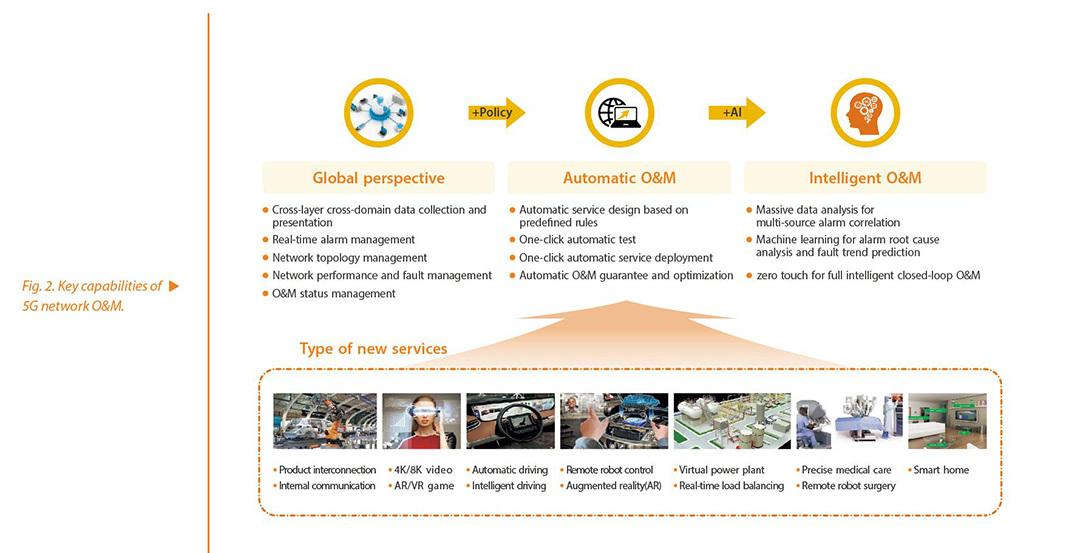Promoting 5G Commercialization From Three Aspects

2019 is recognized as the first year of 5G. SK Telecom, KT and LG U+ from South Korea officially launched 5G commercial services for ordinary consumers on 5th April 2019. This was followed by the Federal Communications Commission (FCC) who announced its third millimeter-wave spectrum auction on April 16th, promising to invest more than $20 billion to deploy 5G in rural areas. China Unicom announced the launch of a 5G network trial in 40 cities at the Shanghai Partner Conference on April 23rd. Although the wave of 5G commercialization has gradually started all over the world, it is still necessary to further improve the commercial capabilities in terms of 5G industrial technology maturity, service development and business model, and efficient network O&M, to expand the commercial scene and scale of 5G networks, and to promote the continuous deepening of 5G commercialization.
5G Industrial Technology Maturity
In June 2018, the 3GPP Plenary Meeting (TSG#80) approved the freeze of 5G standalone (SA) networking function, marking the official release of the truly complete international 5G standards. Different from the 4G standards, 5G standards are characterized by multiple application scenarios, diverse networking modes, and core network re-architecture. Specifically, 5G standards not only support enhanced mobile broadband (eMBB) scenarios, but also support ultra-reliable and low latency communications (uRLLC) and massive machine type of communication (mMTC) scenarios. 5G standard network architecture is divided into two categories: non-standalone (NSA) and standalone (SA). NSA is subdivided into Option 3/3a/3x, Option 4/4a, and Option 7/7a/7x, while SA is subdivided into Option 2 and Option 5. 5GC also introduces virtualization, service-based architecture, stateless design and HTTP protocol, and reconstructs the 5G core network with IT technology. So far, 5G standards for eMMB scenarios, whether NSA or SA, have been frozen, uRLLC will be frozen in 2020, NB-IoT and eMTC are defined as 5G features, and mMTC will be completed in R17.
In terms of industrial chain maturity, NSA smart phones have been commercialized, and NSA/SA dual-mode chips and smart phones are expected to be mass-produced in Q3–Q4 2019. Mainstream equipment vendors have long been waiting for 5G commercialization. NSA/SA dual-mode base stations as well as NSA/SA converged core networks have been tested and verified, and will have large-scale commercial capacity in the second half of 2019.
According to the mobile trend report released by GSMA, South Korea and the United States have launched 5G services, and China and the United Arab Emirates will also launch 5G commercial services in 2019. There will be 100,000 5G base stations deployed in China, and 5G services will cover dozens of cities in 2019. More than 10 countries and regions in Canada, Mexico, Australia, Japan and the Asia-Pacific region (except China, Japan and Korea) and more than 20 countries in Europe will also launch 5G commercial services in 2020. By 2025, the number of 5G users worldwide is expected to reach 1.36 billion.
On the whole, 5G industrial technologies are ready for commercial use in eMBB scenarios and still need to be improved for applications in uRLLC and mMTC scenarios.
5G Service Development and Business Model
When 5G was born, technologies such as AI, IoT, cloud computing, big data and edge computing were also booming. The 5G network that combines these technologies is no longer comparable to traditional ones. 5G is highly regarded not only by the industry but also by the whole society. 5G network can provide large bandwidth, low latency, massive connections, and high reliability. These performances and features are either ten or tens of times higher than 4G or are not available on 4G. 4G changes life, while 5G changes society. 5G not only upgrades existing 4G services, enhances personal digital experience, but also creates new services (Fig. 1). Typical new services, such as cloud AR/VR, cloud gaming, personal video live broadcast and other immersive real-time video services are only the first wave of 5G applications and are the natural evolution from 4G MBB to 5G eMBB to address the capacity requirements of large bandwidth services at a lower bit cost. With the introduction of uRLLC and mMTC, 5G will also bring about industrial change in the internet of everything. It provides industry applications such as auto-driving based on internet of vehicles, intelligent manufacturing based on drones and industrial robots, and telemedicine, smart city, and smart agriculture based on low-latency connections.

Although the cost per bit for mobile broadband has been reduced in the 5G phase, competition and policy have also made it more difficult to monetize traffic. The vertical industry has a beautiful scene and huge space, but the current standards and industrial maturity are still relatively low. Therefore, the existing business model of mobile networks can no longer support sustainable development of 5G. Do operators need to introduce a variety of billing methods such as charge by traffic, by rates, by number of connections, by time latency, by slice, or by slice plus SaaS for different scenarios to support new business models including traffic value, rate value, connection value, latency value, and slice value? All these need to be explored in advance and nurtured for a long time.
Multi-access edge computing (MEC) and network slicing are hot topics in the 5G field. The ultra-low latency, high bandwidth, and high-speed mobility of 5G services have given birth to local services. The determination of latency and continuity of local services and the need for ultra-high computing power need to achieve the organic combination of connectivity and computing power at the edge of the network, otherwise it is difficult to meet the requirements of local services. It is worth noting that only by effectively utilizing the connection ability can the edge computing power distributed at one or more points be effectively coordinated to realize sharing of data and capacity and improve automation and intelligent efficiency at a lower cost. Accordingly, is the business model of edge computing a simple monetization of connectivity, or a monetization of computing power, or a monetization of the combination of connectivity and computing power? These also need to be further explored.
Network slicing is similar to logical network or virtual private network. With the introduction of NFV/SDN, network slicing can generate an almost unlimited number of end-to-end logical networks on a physical network any time, anywhere and can provide multiple slices for the same user to achieve a variety of bandwidth, latency, number of connections and security isolation services under different resource requirements. Although the virtualized 4G network can implement some similar functions through DeCore/e-DeCore, the slicing of 5G network is native and end-to-end. From terminal to network, the slicing capability is more flexible and complete. Similarly, the business model of 5G slicing is also vague. The major concern is how to effectively use 5G slicing to serve the vertical industry and whether to act as an e-commerce and settlement platform for online sales of many businesses and become an interconnected business platform for many enterprise users to achieve digital and intelligent transformation.
5G is not only a pipeline, but also the innovation of business model, the change of service mode and the innovation of vertical business integration. The commercial scale of 5G network needs to explore possible new business models in advance, and push 5G onto the benign track of sustainable development through both quantitative and qualitative change.
5G Network O&M
The goal of 5G network is to achieve the service provisioning time in minutes and realize transmission latency within tens of milliseconds for 90% of areas, providing users with a visual, optional and self-service network experience. In the 5G era, the traditional way of network O&M has become inadequate.
First, due to the introduction of SDN/NFV, network devices are virtualized, and service functions and connections can be dynamically loaded and orchestrated. The network will no longer be a simple sub-domain, but horizontal sub-domain, vertical hierarchical cloud-network synergy. The difficulties of automatic deployment, testing, upgrade, monitoring, optimization, and cross-layer cross-domain fault location of network elements and services will increase significantly.
Second, 5G network is a distributed network with separate control plane and forwarding plane. To improve resource utilization, O&M efficiency, and the speed of service delivery, centralized deployment of control plane in a big area will become a trend. Both centralized deployment and centralized O&M will inevitably pose challenges to the existing structure, O&M process, and BOSS system.
Third, existing networks are probably in a multi-vendor equipment environment. The urgent problem to be solved is how to implement unified management and automatic end-to-end orchestration of multi-vendor equipment including access, transmission, and core network, and how to unify network capability API to realize open network capability and end-to-end slicing operation.
5G network must introduce new technologies to achieve automatic and intelligent network O&M. Global perspective, automatic O&M, and intelligent O&M are three key capabilities of 5G network O&M (Fig. 2). The global perspective capability involves cross-layer cross-domain data collection and presentation, real-time alarm management, network topology management, network performance and fault management, and O&M state management. The automatic O&M capability includes automatic service design based on predefined rules, one-click automatic test, one-click automatic service deployment, automatic O&M guarantee and optimization. The intelligent O&M capability contains massive data intelligent analysis for multi-source alarm correlation, machine learning for alarm root cause analysis (RCA) and fault trend prediction, and zero touch for full intelligent closed-loop O&M.

The automation of 5G network O&M is still in the stage of end-to-end automatic deployment and orchestration for single-vendor equipment, and the end-to-end automation for multiple-vendor equipment is being explored. The intelligence of network O&M has just started, and it is still far from the 5G network to realize zero touch closed- loop intelligent O&M and intend-driving network. However, the more confused you are, the more you have to look into the distance, and the more you can see the future ahead.
Internet was born in 1969, and this year marks its 50th anniversary. In the past 50 years, internet has developed at an amazing speed and penetrated into various industries of human society, which not only brings about great social changes, but also brings some bubbles and problems. This year is the first year of 5G. When the "50th anniversary of internet" meets "the first year of 5G", let us jointly promote the continuation of 5G commercialization from three aspects: industrial technology maturity, service development and business model, and network O&M.